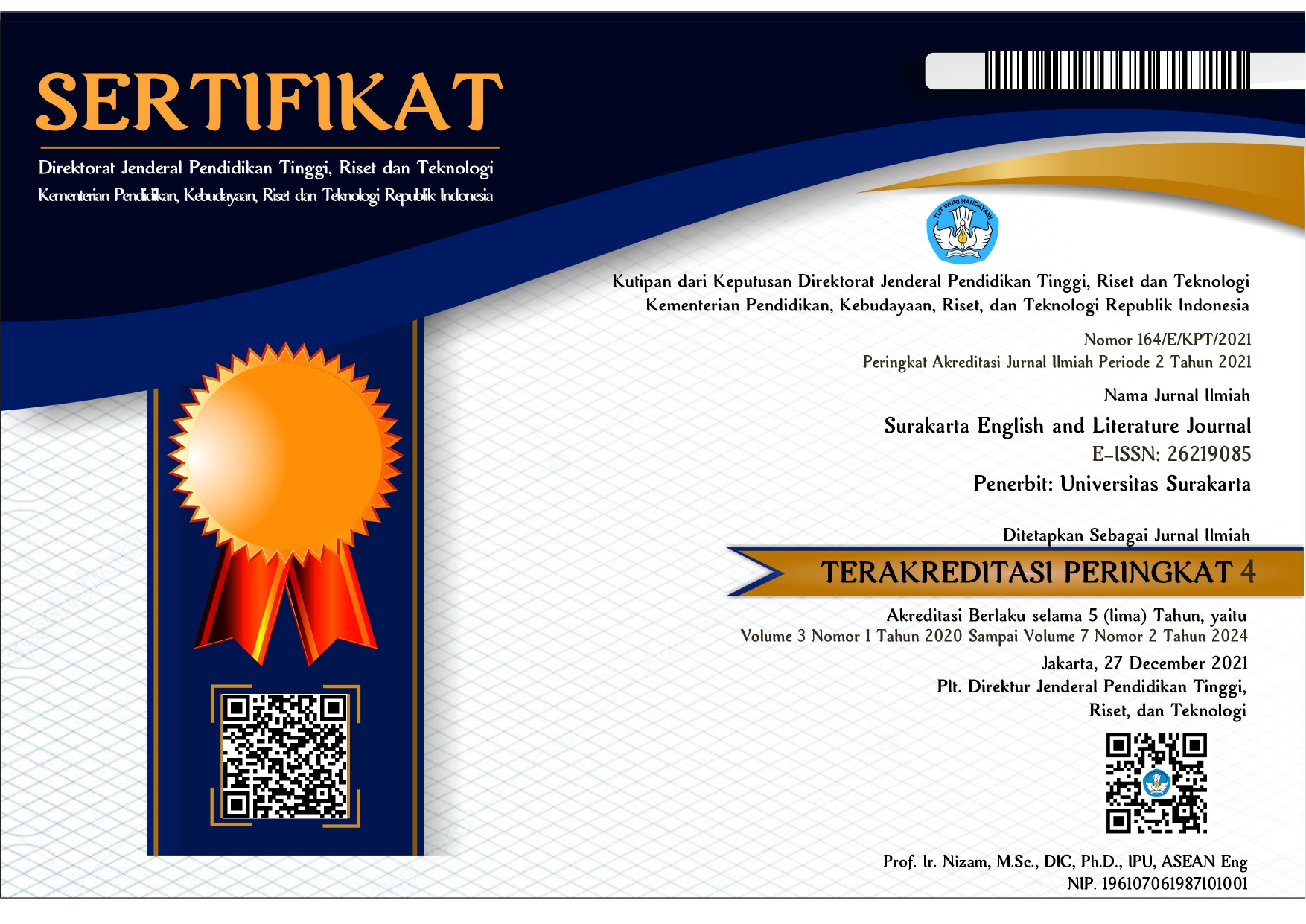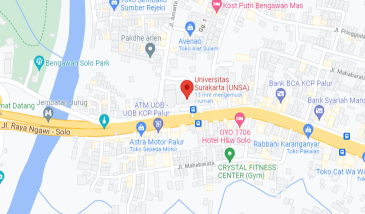Students' Perception of Vlog as A Self-Learning Media in Speaking
DOI:
https://doi.org/10.52429/selju.v5i2.7Keywords:
Speaking, Vlog, Self-Learning, Learning MediaAbstract
Speaking is one of the most challenging skills in learning English. Many obstacles are faced when learning to speak, such as lack of motivation, fear of making mistakes, and lack of self-confidence. These problems are often found during the teaching and learning process in the classroom. A teacher is expected to continue innovating for exciting and fun learning methods and media to increase learning interest, motivation, confidence, and creativity in speaking. It is needed not only in the classroom but also in independent learning. This study aims to discover students' perception of the learning process for their speaking skills through using vlogs as a self-learning media and the effect of using vlogs on students' motivation, confidence and creativity. The researcher took the research object of the English Language Teaching Department students in UNU Purwokerto. The data were obtained by giving a speaking project as a vlog with a specific theme. Data collection was conducted by providing questionnaires and interviews to find out students' perceptions about the effect of using vlogs for the improvement of motivation, confidence and creativity and also observing the students' vlogs to find out the learning process of speaking from the aspect of pronunciation, grammar and vocabulary. Data analysis is qualitative descriptive with theories from Dulay and Fromkin (1982). This study found that based on students' perceptions, they agreed that using vlogs improved their motivation, confidence and creativity. Meanwhile, based on the observation, it was found that there were some pronunciation errors and grammar mistakes in the students' speaking, but they showed improvement in choosing vocabulary. Some students used a variety of vocabularies that were rarely used in the class.
References
Afrilliani, G., Darmalaksana, W., & Mulyana, A. (2020). The Use of Vlog to Improve Students' Speaking Skills. Bandung English Language Teaching International Conference, Beltic 2018, 1(1), 531–539.
Anggareni, C. W., & Wulanjani, A. N. (2017). The Roles of Ted Talks and Vlog in Speaking Class: Students’ Perspectives. TRANSFORMASI Journal Informasi & Pengembangan Iptek, 13(1), 47–52.
Arianti. (2021). A Study of Students' Efforts to Improve the Ability in English. Surakarta English and Literature Journal, 4(1), 1–10.
Arsyad, L., Akhmad, E., & Bayan, F. Al. (2021). Vlog as Alternative Media in Teaching Speaking for Millenial Learners. English Language and Literature International Conference (ELLiC), 4(2), 48–56.
Arumsari, & Octaviani. (2021). The effectiveness of Virtual Learning on English Speaking Skill for Students of Information System. Surakarta English and Literature Journal, 4(1), 32–43.
August, D., Carlo, M., Dressler, C., & Snow, C. (2005). The critical role of vocabulary development for English language learners. Learning Disabilities Research & Practice, 20(1), 50-57.
Aydin, S. (2014). The Use of Blogs in Learning English as a Foreign Language. Mevlana International Journal of Education (MIJE)Ducation (MIJE), 4(1), 244–259.
Brewer, S. S. (2016). Developing Self-Directed Learning in the Language Classroom: The Work of Leni Dam. International Journal of Self-Directed Learning®, 26.
Creswell, J. W. (2012). Educational research; planning, conducting, and evaluating quantitative and qualitative research. Upper Saddle River, NJ: Pearson Prentice-Hall.
Dulay et al. (1982). Language Two. Oxford: Oxford University Press.
Fromkin, V., Rodman, R., & Hyams, N. (2013). An Introduction to Language (10th ed.). New York: Wadsworth Cengage Learning.
Henderson, J. (2012). Students Spend More Time with Digital Gadgets than in Class. Retrieved from https://www.stltoday.com/entertainment/books-and-literature/book-blog/students-spend-more-time-with-digital.
Hosni. (2014). Speaking Difficulties Encountered by Young EFL Learners. International Journal on Studies in English Language and Literature (IJSELL), 2(6), 22–30.
Khan, Raja M.I et al. The Role of Vocabulary Knowledge in Speaking Development of Saudi EFL Learners. Arab World English Journal, 9(1), 406-418.
Limeranto, J., & Bram, B. (2022). Exploring EFL Graduate Students' Perspectives and Strategies to Improve English Speaking Skills. Surakarta English and Literature Journal, 5(1), 26–38.
Maldin, S. A., Reza, S., & Rezeki, I. (2018). Stepping Up the English-Speaking Proficiency of Hospitality Students through Video Blogs (Vlogs). Advances in Social Science, Education and Humanities Research (ASSEHR), 148(4), 58–63.
Mandasari, B., & Aminatun, D. (2020). Improving Students' Speaking Performance Through Vlog. Journal of English Teaching and Research, 5(2), 136–142.
Maulidah, I. (2018). Vlog: The Mean to Improve Students' Speaking Ability. Advances in Social Science, Education and Humanities Research (ASSEHR), 145(2), 12–15.
Muhammad, M. (2016). Pengaruh Motivasi dalam Pembelajaran. Lantanida Journal, 4(2), 88–97.
Mutmainna, M. (2016). Implementing Blogs as a Learning Tool in Asian EFL/ESL Learning Context. BRAC University Journal, XI(1), 27–35.
Kurniawan, F. (2016). The Use of Audio-Visual Media in Teaching Speaking. English Education Journal, 7(2), 180–193.
Pravitasari, et al. (2021). Error Analysis on the Students’ English Speech of STMIK Sinar Nusantara. Surakarta English and Literature Journal, 4(1), 11–19.
Ramasari, M. (2017). Students' Pronunciation Error Made in Speaking for General Communication. Linguistic, English Education and Art (LEEA) Journal, 1(1), 37–48.
Rod Ellis. (2008). Learner Beliefs and languange Learning. Asian EFL Journal, 10(4).
Safitri, & Khoiriyah. (2017). Students' Perceptions on the Use of English Vlog (Video Blog) to Enhance Speaking Skill. The 5th Asian Academic Society International Conference, 240–247.
Sanaky, Hujair AH. (2013). Media Pendidikan: Pengertian, Pengembangan dan Pemanfaatan. Jakarta: Raja Grafindo Persada.
Sanjaya, Wina. (2011). Strategi Pembelajaran Berorientasi Standar Proses Pendidikan. Jakarta: Kencana Prenada Media Group.
Snelson, C. (2013). New Media Soc. 17 Vlogging about School on Youtube: An Exploratory Study., 321-339. https://doi.org/10.1177/1461444813504271
Susanti, E. D. (2019). Project based Learning: Pemanfaatan Vlog dalam Pembelajaran Sejarah untuk Generasi Pro Gadget. Sejarah Dan Budaya: Jurnal Sejarah, Budaya, Dan Pengajarannya, 13(1), 85–96. https://doi.org/10.17977/um020v13i12019p84
Valimbo, IA & Hartati, Elysa. (2018). Vlog To Improve Students Speaking Skill: A Classroom Action Research. Prosiding Konferensi Pendidikan Nasional “Penguatan Karakter Bangsa Melalui Inovasi Pendidikan di Era Digital.”
Vazariah, U., & Rozimela, Y. (2020). An Error Analysis on Verb Usage in the Texts Written by EFL Senior High School Students. Journal of English Language Teaching, 9(1), 231–240.
Watkins, J. (2012). Increasing Student Talk Time Through Vlogging. Language Education in Asia, 3(2), 196–203. https://doi.org/http://dx.doi.org/10.5746/LEiA/12/V3/I2/A08/Watkins
Downloads
Published
How to Cite
Issue
Section
License
Copyright (c) 2022 Dinar Faiza, Ade Christanty Yudha Bestari, Meilina Haris Mayekti

This work is licensed under a Creative Commons Attribution-ShareAlike 4.0 International License.
Licensing for Data Publication
-
Open Data Commons Attribution License, http://www.opendatacommons.org/licenses/by/1.0/ (default)
-
Creative Commons CC-Zero Waiver, http://creativecommons.org/publicdomain/zero/1.0/
-
Open Data Commons Public Domain Dedication and Licence, http://www.opendatacommons.org/licenses/pddl/1-0/














